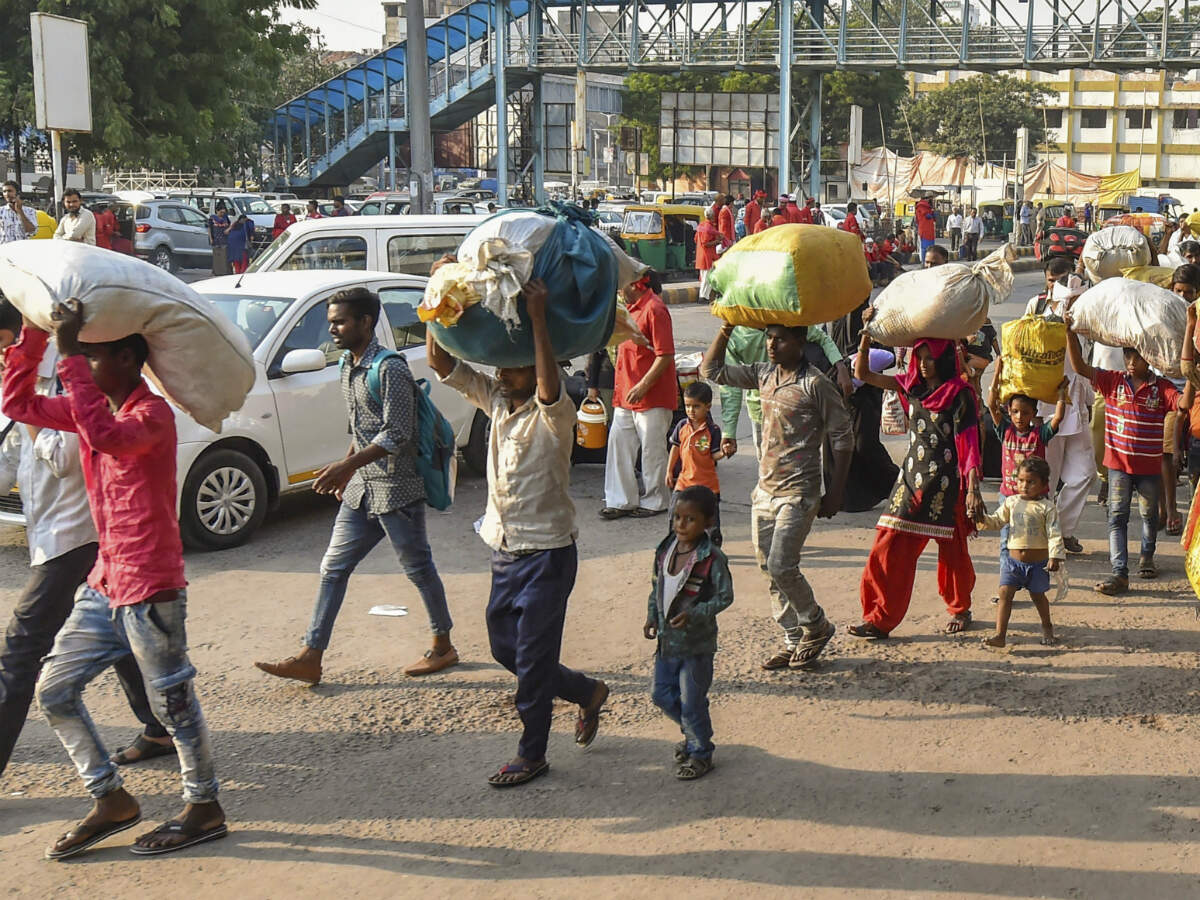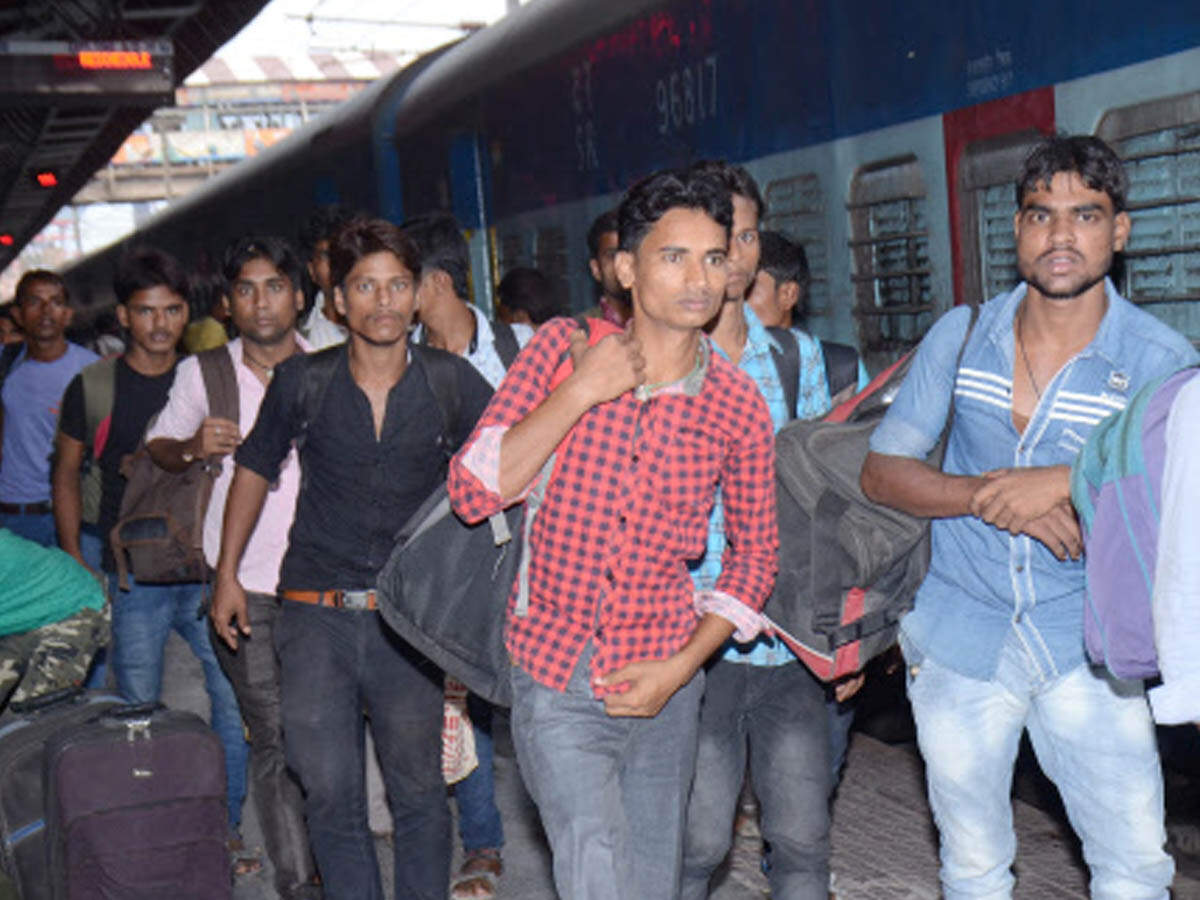Migrants make up 70% of workforce in Surat, 50% in Ahmedabad: Study
Parth Shastri | TNN | Updated: Oct 12, 2018, 13:49 ISTHighlights
- About 5 lakh workers from different states form the basis of industrial units in ‘Vibrant Gujarat'.
- According to a study, about 70% of Surat’s workforce and 50% of Ahmedabad’s workforce is migrant.
- "The current anti-migrant hysteria will hopefully be short-lived,” says an IIM professor
 People stand in a queue at Ahmadabad station to board a train to Uttar Pradesh.
People stand in a queue at Ahmadabad station to board a train to Uttar Pradesh.AHMEDABAD: As the issue of migration is raging on following the recent attacks on labourers from north Indian states, the experts point out that a population of over five lakh from different states forms the basis of industrial units in ‘Vibrant Gujarat.’
Chinmay Tumbe, assistant professor of economics area at IIM-Ahmedabad, said that migrants make up about 70% of Surat’s workforce and 50% of Ahmedabad, higher than most of the major cities of India.
While for other cities of Gujarat the number is less, it is still substantial, he added. Tumbe’s book ‘India Moving: The History of Migration’ was published earlier this year.


“The major genesis is the Mulki-non Mulki conflict observed in Nizam-ruled Hyderabad in the 19th century with impacts lingering till the formation of Telangana state. Mumbai and Assam have been the other hotbeds of anti-migrant rhetoric and sentiment. But in most parts of India, it has not reared its ugly head in open confrontation,” he said, adding that friction can also be expressed in terms of delayed wage payments or provision of fewer social security benefits.
Tumbe said that historically Punjab and Gujarat have harboured fewer anti-migrant sentiments as they themselves are known to be migrating across the globe extensively. “The current anti-migrant hysteria will hopefully be short-lived,” he said.


Migrant workers who have a choice to migrate between Gujarat and Kerala prefer the latter because of better labour benefits. “Migrant friendly labour policies should be a priority for Gujarati enterprises to attract the best labour talent in the country that would enhance the firms’ performance,” said Tumbe.
Chinmay Tumbe, assistant professor of economics area at IIM-Ahmedabad, said that migrants make up about 70% of Surat’s workforce and 50% of Ahmedabad, higher than most of the major cities of India.
While for other cities of Gujarat the number is less, it is still substantial, he added. Tumbe’s book ‘India Moving: The History of Migration’ was published earlier this year.


“The major genesis is the Mulki-non Mulki conflict observed in Nizam-ruled Hyderabad in the 19th century with impacts lingering till the formation of Telangana state. Mumbai and Assam have been the other hotbeds of anti-migrant rhetoric and sentiment. But in most parts of India, it has not reared its ugly head in open confrontation,” he said, adding that friction can also be expressed in terms of delayed wage payments or provision of fewer social security benefits.
Tumbe said that historically Punjab and Gujarat have harboured fewer anti-migrant sentiments as they themselves are known to be migrating across the globe extensively. “The current anti-migrant hysteria will hopefully be short-lived,” he said.


Migrant workers who have a choice to migrate between Gujarat and Kerala prefer the latter because of better labour benefits. “Migrant friendly labour policies should be a priority for Gujarati enterprises to attract the best labour talent in the country that would enhance the firms’ performance,” said Tumbe.
From around the web
More from The Times of India
From the Web
More From The Times of India

Rare blood disorder is threatening to kill my 16-yr-old son.
KETTO
Discover cheap flight tickets with FareMachine!
FareMachine
Never lose a picture again thanks to this innovative device
The Photo Stick
Explore endless entertainment for $15/mo.
SLING INTERNATIONAL
Master the skills of a Cloud Architect at Simplilearn
SIMPLILEARN








































All Comments ()+^ Back to Top
Refrain from posting comments that are obscene, defamatory or inflammatory, and do not indulge in personal attacks, name calling or inciting hatred against any community. Help us delete comments that do not follow these guidelines by marking them offensive. Let's work together to keep the conversation civil.
HIDE